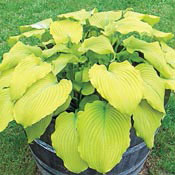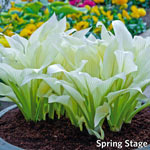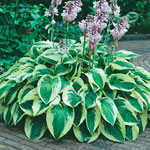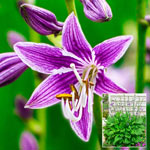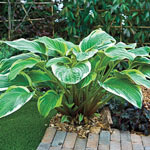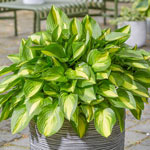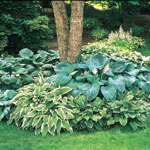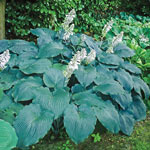Hostas
An Overview of the Hosta Plant
Make the most of your yard by incorporating attractive, appealing Hostas into your shady-area plantings. Hostas range in size from tiny plants less than 8 inches tall to 4-foot clumps with leaves nearly 2 feet across. Leaves come in a wide choice of shapes and textures, and may be solid or variegated in shades of green, white, yellow, cream and even blue. Popular for their interesting foliage, these shade-loving perennials also provide lovely splashes of lavender, white or yellow in the summer, when hosta plants bloom.Who says shade plants must be boring? Our hosta plants provide pretty blooms and prettier foliage. Bordered leaves, striped varieties, striking colors and our Super Sak hostas are sure to add interest.
Where Are the Best Places to Plant Hosta Bulbs?
Form and function come together beautifully in these fabulous, fun plants. Often used as ground cover, hostas are effective in erosion control, which makes them great for placement on slopes, berms or behind retaining walls. Tiny hostas work wonders in containers, as border plants or in terrariums. Medium-sized hostas make superb companions to shade-loving plants and flowers such as astilbe, impatiens or coleus, while larger varieties create striking stand-alone focal points even in larger yards.Do hostas like sun or shade?
Hosta plants love the shade, but some hostas require more sun than others. A general rule of thumb is that lighter foliage indicates a need for more sunlight while darker foliage grows best in the shade. Dappled sunlight works best for more colourful varieties. In general, planting hosta bulbs in a woodland garden, beneath a large tree or on the north side of a house is a good bet.Are hostas good for landscaping?
When it comes to landscaping, hostas are especially beautiful and lush when grown next to textured plants like ferns. Hostas also look amazing in gardens surrounded by bright, colourful flowers. Remember to match the estimated size of the mature plants with your available space.Do hostas spread?
Hostas are fast growers once established, growing from rhizomes that get bigger and split underground. Once you have a few hostas set and growing, you'll soon have more hostas growing from rhizomes that have replicated just a few inches below the soil. It's one of the best elements of hostas-their quick growth and easy propagation means that you'll get a ton of bang for your buck with this shade-friendly plant.How to Plant Hosta Bulbs
Hostas are long-lived shade plants that should be grown in rich, slightly acidic soil in a spot where they will not receive much sun. To start, dig a hole about a foot deep and slightly wider than the mature hosta plant. They can vary greatly in size, so know how large you can expect yours to grow. Place a plant in the hole and add in some form of organic matter such as compost, composted manure or tree bark mulch. Finally, fill the hole with soil and cover with mulch.Hostas are tough, versatile and easy to grow, and most types spread quickly once they are established. Their rhizome clumps can be divided every few years into smaller clumps that can be shared with relatives and friends who also enjoy gardening.
How Do you Care for Hosta Bulbs?
Hosta bulbs are easy to care for, and extremely winter-hardy. While they don't need constant watering, they do require a drink during dry spells, and can wilt if they become too dried out. Fertilize your hostas in the spring, and consider mulching around your hosta plants if they tend to dry out quickly.Do hostas grow bigger every year?
Hostas reach their mature height and size in about two to four years. Once your hostas have matured, they won't keep growing taller. However, hostas do propagate underground. Their rhizomes enlarge, split, and create new plants just a couple of inches below the soil's surface. So, while hostas don't become larger every year, they do tend to spread.You won't need to worry about hosta growing out of control, however. Dividing and removing hosta is extremely simple, and doing so every few years can keep your plants healthy and prevent overcrowding.
What do you do when your hostas get too big?
Hostas are easy to split. If you find that your hostas have become overcrowded, or simply that you have too many for the space in which you planted them, it's time to divide! Use a spade to unearth your hosta rhizomes, and gently brush the soil off the clump. Then, break the pieces of the rhizome apart, leaving at least one sprout on each clump you want to re-plant.Replant the hosta you want to keep, and choose what to do with the rest. You can replant the hostas in new areas of the landscape, give unwanted hostas to other gardeners, or simply dispose of your extra hosta clumps.








